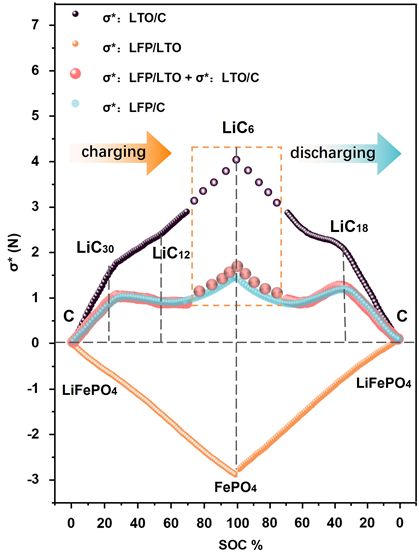Current position: Home >> NEWS >> Research News
Xingmin He et al published their article in Chemical Engineering Journal

Mechanistic insights into the dynamic evolution processes of LiFePO4/C batteries
Lithium iron phosphate/graphite (LFP/C) lithium-ion batteries are widely used in energy storage systems due to their superior performance, yet the formation mechanism of the non-monotonic saddle-shaped stress curve induced by mechano-electrochemical coupling during charge/discharge remains unclear. This stress curve, indirectly reflecting dynamic electrode evolution via sensors, is employed for state-of-charge (SOC) estimation and state-of-health (SOH) monitoring. However, LFP/C batteries exhibit distinct stress behavior compared to other lithium batteries (e.g., NCM, LMO), with non-monotonic features (e.g., curve inversion within the 23.9%–51.8% SOC range) defying single-electrode explanations. By introducing zero-strain lithium titanate (LTO) as a stress reference electrode (SRE), the stress signals of LFP and graphite electrodes were independently measured for the first time, enabling the construction of a mechano-electrochemical coupling model combining X-ray diffraction (XRD) and lithiation behavior. Results reveal that the asymmetric reaction pathways (e.g., LiC30→LiC12 phase transition) and multi-step, low-strain-rate phase transitions in graphite overshadow the single-phase volume changes in LFP, leading to the non-monotonic stress profile. Within the non-monotonic interval, strain hysteresis driven by graphite phase transitions dominates, contradicting prior assumptions attributing the behavior to LFP two-phase coexistence. By establishing a mapping relationship between stress signals and electrode reactions, the study proposes an analytic expression for the stress curve, enabling dynamic battery evolution analysis solely via stress data. This advance provides a theoretical foundation for stress-based state monitoring and fault diagnosis technologies.
May 2025
